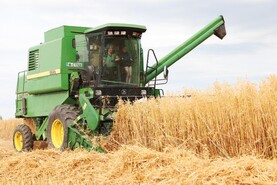Mixed weather is making it difficult for those with crops ready to cut to get out with combines, although many crops are still not ready to be harvested.
The weather forecast for this week looks showery, so this will delay progress where crops are ready to be cut.
At present, there is also rain in the forecast for early next week.
The winter barley harvest is off to a slower start than recent years and this is no harm, as it may mean a bit more grain fill in crops which struggled to establish last autumn and in many cases are patchy.
Next week will likely see a peak of activity in the fields.
Start
Some have made a start and, as would be expected, moisture contents are high, above 20% and hitting 24% for many. Those hitting the top end of the moisture levels at 23% to 24% are turning back in most cases.
Most of the action so far has been in the south of the country, but there were combines moving in most parts.
Further south is where better yields are expected as well, as crops generally look to be in better condition, though there are poor crops across the country.
Yield reports so far are few, as many had not cut full fields or did not have crops weighed.
Reports from some crops are of yields of between 3.74t and 4t/ac, but at moisture contents of around 21%, so they are not hitting the 4t/ac mark at 20% moisture content.
KPH or bushel levels are mixed so far, with reports of between 61 and 69.
The majority of harvesting so far is on six-row varieties, which tend to be ready a bit earlier than two-rows, although some two-row varieties, such as KWS Tardis, have been cut.
It is early to report on straw yields, as little baling is being carried out. However, with a 30% or 38,000ha decline in the area of winter cereals, demand for straw is set to be strong. Prices of €30/bale (4X4) are being quoted at present.






 This is a subscriber-only article
This is a subscriber-only article










SHARING OPTIONS: